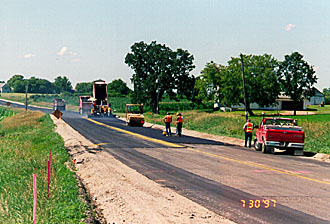U.S. Department of Transportation
Federal Highway Administration
1200 New Jersey Avenue, SE
Washington, DC 20590
202-366-4000
Focus
| Accelerating Infrastructure Innovations |
Publication Number: FHWA-SA-98-025
Date: September 1998
As reported previously in Focus, the Superpave system is becoming the mix design system of choice among State highway agencies. But what do paving contractors think about the new mix design system?
To answer that question, Dale Decker, vice president of research and technology for the National Asphalt Pavement Association (NAPA), recently conducted an informal survey of NAPA's members. The 20 contractors surveyed built a total of 68 Superpave projects using 2.75 million tons of Superpave mix on urban and rural roads in 1997, more than half of which carried high traffic volumes.
Overall, the survey respondents reported generally positive results with the Superpave system. They emphasized that Superpave pavements do require that contractors pay close attention to detail and follow good mix production procedures and pavement construction practices. Here's a summary of some of the key findings of the survey.
Implementation of the Superpave binder specification has gone smoothly, with the respondents reporting no trouble procuring performance-graded (Superpave system) binders from their usual suppliers.
Ninety-five percent of the respondents were able to obtain aggregates that met the Superpave guidelines from their usual suppliers. However, the aggregates did differ somewhat from those used in conventional mixes.
Almost three-fourths of the Superpave mixes were designed by the contractor. Most (85 percent) of those mixes met all of the Superpave requirements, even though only 70 percent of the projects were required to meet all Superpave specifications. Survey respondents said most of the mixes were surface courses and used 12.5-mm or 19-mm aggregate gradations.
The switch to Superpave mixes had little effect on asphalt plant operations, survey respondents said. In general, producing Superpave mixes is "business as usual," so long as you pay attention to details such as gradation control and binder storage.
Decker cautions that contractors should be prepared to explain to commercial customers that "Superpave mixes may look different than what they're used to getting."
Eighty-five percent of the respondents had no problems with paving operations, and 90 percent said the paving speed was unchanged. Eighty-five percent did note, however, that handwork was more difficult with Superpave mixes. All respondents emphasized the importance of following good paving practices.
Although 85 percent of the respondents were able to consistently achieve the desired density for Superpave pavements, half said it was harder to achieve.
The key, survey respondents said, is to follow good practices. "Compaction can be more difficult, but when you get the right equipment and the right pattern, it's achievable," says Ken Murphy, president of Asphalt Technologies, Inc., a subsidiary of Anderson Columbia Co. "More effort is involved, but the effort is worth it."
Respondents said Superpave mixes had the same range of variation in the percentage of asphalt cement and mix volumetrics as conventional mixes. Seventy percent said Superpave pavements generally had the same surface texture as conventional pavements, and none of the respondents saw an increase in bleeding, fat spots, or checking.
The Superpave system does, however, make quality control more important, says Jack Weigel of Payne and Dolan, Inc., in Wisconsin. "Superpave mixes are more sensitive to subtle changes," he says. "We've found that sometimes we need to run daily tests of the combined specific gravity of aggregates."
So what do paving contractors think of the Superpave system? "Adoption of the Superpave system is going fairly well, but some technical issues remain to be sorted out," says Decker. But in spite of occasional difficulties, contractors are impressed with the Superpave system.
"I think the Superpave system does a better job of evaluating aggregate combinations, and the Superpave gyratory compactor is a better match to what happens on the road than the Marshall hammer," says Weigel.
Murphy concurs, adding, "I think it's the answer to rutting problems."
For more information on the Superpave survey, contact Dale Decker at NAPA (phone: 301-731-4748; fax: 301-731-4621; ).

Contractor Payne & Dolan used a mix designed with the Superpave system to pave a rural road in Wisconsin.
Answers to many Superpave paving and compaction problems can be found in Superpave Construction Guidelines, published jointly by NAPA and the Federal Highway Administration (see March 1998 Focus). To order, contact NAPA at 301-731-4748 (toll free: 888-468-6499; fax: 301-731-4621; Web: www.hotmix.org).